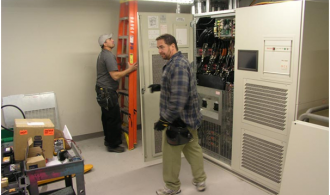Uninterruptible power supplies (UPSs) are usually something that we think of in terms of protecting computers, but they can be employed on a much larger scale too, to protect whole buildings in fact.
Why Protect?
Why might you want to do this? It’s essential in protecting things like medical facilities and emergency services – you wouldn’t want the lights to go out while you were on the operating table for example. UPS protection is also commonplace for data centres and other facilities essential to businesses, such as trading floors or even industrial processes. British Airways recently found out the hard way about the effect of a power outage on its business.
A UPS might also be used to protect essential emergency systems too. These include backuop communications systems, emergency lighting and alarm systems essential to protect premises from fire or theft.
UPS or Generator?
Many large organisations rely on a standby generator to provide backup power. However, this isn’t in itself a complete answer. There’s a delay between the mains failing and the generator kicking in. Being battery-based, a UPS comes into action straight away so there’s no interruption. It can therefore be used to bridge the gap between the mains going down and a generator starting up.

UPS installations come in different forms. These range from compact, stand-alone units to protect individual devices, to larger units installed in cabinets or incorporated in a generator installation. An Eaton UPS distributor like http://www.cppsales.com/Eaton_UPS_Systems___Accessories-catid17 should be able to advise you on the best option for your business needs.
Automatic Protection
For any type of installation it’s important that there is some degree of automatic protection. This ensures that the UPS system operates instantly and there is no interruption at all to operation. The system should allow enough time for an orderly shutdown of systems, or allow them to keep going until an alternative power source such as a generator can be established.
It’s also possible to combine a number of smaller UPS units together to cover a degree of redundancy. This means that should one or more units fail there will still be sufficient capacity to keep things going.
Whatever the size of your business and the nature of the operation, it’s vital to plan your UPS needs carefully in order to ensure you have the necessary level of protection.

